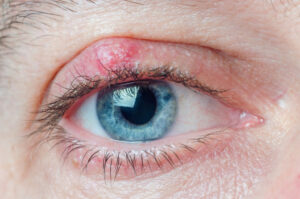Blepharospasm is a neurological disorder that involves involuntary twitching or closure of the eyelids. While the condition is not life-threatening, it can severely impact a person’s quality of life by interfering with daily activities such as reading, driving, or even social interactions. Homeopathic treatments aim to address the root cause of blepharospasm and provide long-lasting relief by targeting the nervous system’s imbalance. In this detailed article, we will explore the various aspects of blepharospasm, including symptoms, causes, risk factors, and how homeopathy can help.
Overview
Blepharospasm is a form of focal dystonia that primarily affects the muscles controlling the eyelids. It leads to uncontrolled blinking, twitching, and spasms that can occur in one or both eyes. The severity of blepharospasm can range from mild, infrequent twitching to severe, forceful closure of the eyelids, making it difficult for patients to keep their eyes open.
In most cases, the condition starts gradually and may worsen over time. Although the exact cause is often unknown, it is believed to be related to dysfunction in the basal ganglia, a part of the brain that controls movement. Fortunately, homeopathic treatments provide a natural, individualized approach to treating the symptoms and underlying causes of blepharospasm.
Symptoms
The hallmark symptoms of blepharospasm include:
- Frequent Blinking: Uncontrolled, excessive blinking, which may start intermittently and gradually become more persistent.
- Eye Twitching: Involuntary twitching of the eyelid muscles, typically affecting both eyes.
- Difficulty Keeping Eyes Open: In severe cases, patients may experience difficulty in keeping their eyes open due to the forceful closing of the eyelids.
- Dry or Irritated Eyes: Some individuals may experience a feeling of dryness or grittiness in the eyes, often linked to reduced blinking.
- Facial Spasms: In advanced cases, the spasms may spread to other facial muscles, causing twitching or spasms around the mouth or cheeks.
When to See a Doctor
If you experience any of the following symptoms, it’s important to consult a doctor:
- Persistent Eye Twitching: If twitching lasts for more than a few days or worsens over time, it may be a sign of blepharospasm.
- Severe Eyelid Closure: Difficulty keeping your eyes open, affecting your ability to perform daily activities like reading or driving.
- Pain or Discomfort: If eye twitching is accompanied by pain, discomfort, or a significant impact on your vision.
- Spreading of Symptoms: If spasms spread to other parts of the face, such as the cheeks or mouth.
Early intervention can help prevent the worsening of symptoms and identify underlying causes that need to be addressed.
Causes
The exact cause of blepharospasm is often unknown, but it is believed to result from abnormal functioning of the basal ganglia, a part of the brain involved in motor control. Other potential causes include:
- Neurological Disorders: Conditions like Parkinson’s disease, dystonia, or Tourette syndrome can be associated with blepharospasm.
- Genetic Factors: A family history of dystonia or other movement disorders may increase the likelihood of developing blepharospasm.
- Eye Strain or Fatigue: Prolonged use of computers, reading, or visual tasks can lead to eye strain and trigger spasms.
- Dry Eyes: Irritation caused by dry eyes can sometimes initiate or worsen blepharospasm symptoms.
- Stress or Anxiety: Emotional stress and anxiety may exacerbate muscle spasms, including blepharospasm.
- Medications: Certain medications, particularly those that affect the nervous system, can contribute to the development of blepharospasm.
Risk Factors
Several factors can increase the risk of developing blepharospasm, including:
- Age: Most cases of blepharospasm occur in middle-aged or older adults, typically between the ages of 40 and 60.
- Gender: Women are more likely to develop blepharospasm than men.
- Family History: A family history of dystonia or other movement disorders may increase the risk.
- Eye Conditions: Pre-existing eye conditions, such as dry eyes or light sensitivity, can make a person more susceptible to blepharospasm.
- Chronic Stress: Prolonged emotional stress or anxiety can contribute to the development of muscle spasms.
Complications
If left untreated, blepharospasm can lead to complications that affect your quality of life. These include:
- Impaired Vision: Although blepharospasm does not affect vision directly, severe eyelid spasms can interfere with your ability to see clearly by preventing you from keeping your eyes open.
- Functional Blindness: In extreme cases, the inability to keep the eyes open due to spasms may result in functional blindness, even though the eyes themselves are healthy.
- Social and Emotional Impact: Chronic blepharospasm can lead to embarrassment, anxiety, and depression, particularly if it affects your appearance or ability to engage in social activities.
Prevention
While there is no guaranteed way to prevent blepharospasm, certain steps may reduce the likelihood of developing the condition or help manage its symptoms:
- Manage Stress: Practicing relaxation techniques, such as meditation, deep breathing, or yoga, can help reduce stress levels and prevent exacerbations of blepharospasm.
- Take Breaks from Screen Time: Frequent breaks from computer screens or reading can reduce eye strain and minimize the risk of developing spasms.
- Maintain Eye Health: Keep your eyes moisturized by using lubricating eye drops if you experience dryness. Protect your eyes from irritants like wind or bright light.
- Regular Sleep: Ensuring you get adequate rest can reduce muscle fatigue and stress, both of which can trigger blepharospasm.
Diagnosis
To diagnose blepharospasm, a healthcare professional will typically perform a combination of physical examinations, patient history, and specialized tests. The diagnostic process may include:
- Medical History and Physical Exam: Your doctor will ask about your symptoms, their onset, and any factors that seem to trigger or worsen them. A physical examination will focus on evaluating the involuntary movements and assessing any related conditions.
- Neurological Evaluation: Since blepharospasm is a neurological disorder, a thorough neurological evaluation may be necessary to rule out other movement disorders or conditions affecting the brain.
- Imaging Tests: In some cases, imaging tests like MRI or CT scans may be performed to rule out structural abnormalities in the brain that could contribute to blepharospasm.
Treatments
Treatment for blepharospasm aims to reduce or eliminate the muscle spasms and improve the patient’s quality of life. Conventional treatment options may include:
- Botulinum Toxin (Botox) Injections: Botox injections are commonly used to temporarily paralyze the muscles responsible for the spasms, providing relief for several months.
- Medications: Medications such as muscle relaxants or anticholinergics may be prescribed to reduce muscle spasms. However, these may have side effects and are not always effective.
- Surgery: In severe cases where other treatments have failed, a surgical procedure called a myectomy may be performed to remove some of the muscles controlling the eyelids.
Homeopathy, as a complementary treatment, provides a non-invasive and natural approach to managing symptoms without side effects.
Lifestyle and Home Remedies
In addition to professional treatments, there are several lifestyle changes and home remedies that can help manage blepharospasm:
- Warm Compresses: Applying a warm compress to the eyes can help relax the muscles and reduce spasms.
- Eye Lubrication: If dry eyes contribute to your symptoms, using lubricating eye drops can provide relief and reduce irritation.
- Manage Stress: Practice stress-relieving techniques such as meditation or deep breathing to help reduce muscle tension and prevent exacerbations of blepharospasm.
- Wear Sunglasses: Protecting your eyes from bright lights, wind, and other environmental irritants can reduce triggers for spasms.
Preparing for Your Appointment
To make the most of your appointment, it’s important to be prepared. Consider the following steps:
- Record Symptoms: Keep track of your symptoms, noting their frequency, severity, and any potential triggers.
- Bring Medical History: Provide details of your medical history, including any other neurological or eye conditions you may have.
- List Medications: Bring a list of all medications and supplements you are currently taking, as some may contribute to muscle spasms.
- Prepare Questions: Write down any questions or concerns you may have for your doctor regarding your symptoms, diagnosis, and treatment options.
At HealthKunj Clinics, we offer comprehensive and personalized care for blepharospasm, utilizing homeopathy to address the root cause of the condition and provide lasting relief. Schedule an appointment with our experienced team to start your journey toward better eye health today.

